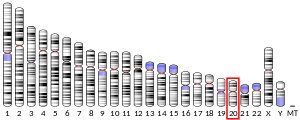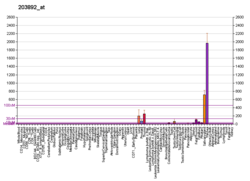WFDC2
WAP four-disulfide core domain protein 2 - also known as Human Epididymis Protein 4[5] (HE4) - is a protein that in humans is encoded by the WFDC2 gene.[6][7][8]
HE4 is a tumor marker of ovarian cancer, with 80% sensitivity at a cut-off of 150 pmol/L.[9]
Function
This gene encodes a protein that is a member of the WFDC domain family. The WFDC domain, or WAP Signature motif, contains eight cysteines forming four disulfide bonds at the core of the protein, and functions as a protease inhibitor in many family members. This gene is expressed in pulmonary epithelial cells, and was also found to be expressed in some ovarian cancers.[5] The encoded protein is a small secretory protein, which may be involved in sperm maturation.[8]
gollark: I'd like to think I can at least make moderately sane font choices.
gollark: Who could possibly think "yes, I will just use a font which makes all the letters the same size, this is a good and not bad change"?!
gollark: For now.
gollark: I disabled those using the [REDACTED].
gollark: BEEEEEEE.
References
- GRCh38: Ensembl release 89: ENSG00000101443 - Ensembl, May 2017
- GRCm38: Ensembl release 89: ENSMUSG00000017723 - Ensembl, May 2017
- "Human PubMed Reference:". National Center for Biotechnology Information, U.S. National Library of Medicine.
- "Mouse PubMed Reference:". National Center for Biotechnology Information, U.S. National Library of Medicine.
- Hellström I, Raycraft J, Hayden-Ledbetter M, Ledbetter JA, Schummer M, McIntosh M, Drescher C, Urban N, Hellström KE (2003-07-01). "The HE4 (WFDC2) Protein Is a Biomarker for Ovarian Carcinoma". Cancer Research. 63 (13): 3695–3700. PMID 12839961. Retrieved 2012-11-28.
- Kirchhoff C, Habben I, Ivell R, Krull N (Mar 1992). "A major human epididymis-specific cDNA encodes a protein with sequence homology to extracellular proteinase inhibitors". Biol Reprod. 45 (2): 350–7. doi:10.1095/biolreprod45.2.350. PMID 1686187.
- Schummer M, Ng WV, Bumgarner RE, Nelson PS, Schummer B, Bednarski DW, Hassell L, Baldwin RL, Karlan BY, Hood L (Dec 1999). "Comparative hybridization of an array of 21,500 ovarian cDNAs for the discovery of genes overexpressed in ovarian carcinomas". Gene. 238 (2): 375–85. doi:10.1016/S0378-1119(99)00342-X. PMID 10570965.
- "Entrez Gene: WFDC2 WAP four-disulfide core domain 2".
- Molina R, Escudero JM, Augé JM, Filella X, Foj L, Torné A, Lejarcegui J, Pahisa J (2011). "HE4 a novel tumour marker for ovarian cancer: Comparison with CA 125 and ROMA algorithm in patients with gynaecological diseases". Tumor Biology. 32 (6): 1087–95. doi:10.1007/s13277-011-0204-3. PMC 3195682. PMID 21863264.
Further reading
- Kirchhoff C (1998). "Molecular characterization of epididymal proteins". Rev. Reprod. 3 (2): 86–95. doi:10.1530/ror.0.0030086. PMID 9685187.
- Kirchhoff C, Osterhoff C, Habben I, Ivell R, Kirchloff C (1990). "Cloning and analysis of mRNAs expressed specifically in the human epididymis". Int. J. Androl. 13 (2): 155–67. doi:10.1111/j.1365-2605.1990.tb00972.x. PMID 1693137.
- Maruyama K, Sugano S (1994). "Oligo-capping: a simple method to replace the cap structure of eukaryotic mRNAs with oligoribonucleotides". Gene. 138 (1–2): 171–4. doi:10.1016/0378-1119(94)90802-8. PMID 8125298.
- Suzuki Y, Yoshitomo-Nakagawa K, Maruyama K, Suyama A, Sugano S (1997). "Construction and characterization of a full length-enriched and a 5'-end-enriched cDNA library". Gene. 200 (1–2): 149–56. doi:10.1016/S0378-1119(97)00411-3. PMID 9373149.
- Bingle L, Singleton V, Bingle CD (2002). "The putative ovarian tumour marker gene HE4 (WFDC2), is expressed in normal tissues and undergoes complex alternative splicing to yield multiple protein isoforms". Oncogene. 21 (17): 2768–73. doi:10.1038/sj.onc.1205363. PMID 11965550.
- Clauss A, Lilja H, Lundwall A (2002). "A locus on human chromosome 20 contains several genes expressing protease inhibitor domains with homology to whey acidic protein". Biochem. J. 368 (Pt 1): 233–42. doi:10.1042/BJ20020869. PMC 1222987. PMID 12206714.
- Hellström I, Raycraft J, Hayden-Ledbetter M, Ledbetter JA, Schummer M, McIntosh M, Drescher C, Urban N, Hellström KE (2003). "The HE4 (WFDC2) protein is a biomarker for ovarian carcinoma". Cancer Res. 63 (13): 3695–700. PMID 12839961.
- Drapkin R, von Horsten HH, Lin Y, Mok SC, Crum CP, Welch WR, Hecht JL (2005). "Human epididymis protein 4 (HE4) is a secreted glycoprotein that is overexpressed by serous and endometrioid ovarian carcinomas". Cancer Res. 65 (6): 2162–9. doi:10.1158/0008-5472.CAN-04-3924. PMID 15781627.
- Clauss A, Lilja H, Lundwall A (2005). "The evolution of a genetic locus encoding small serine proteinase inhibitors". Biochem. Biophys. Res. Commun. 333 (2): 383–9. doi:10.1016/j.bbrc.2005.05.125. PMC 1939935. PMID 15950183.
- Bingle L, Cross SS, High AS, Wallace WA, Rassl D, Yuan G, Hellstrom I, Campos MA, Bingle CD (2006). "WFDC2 (HE4): A potential role in the innate immunity of the oral cavity and respiratory tract and the development of adenocarcinomas of the lung". Respir. Res. 7 (1): 61. doi:10.1186/1465-9921-7-61. PMC 1459147. PMID 16600032.
- Ramachandran P, Boontheung P, Xie Y, Sondej M, Wong DT, Loo JA (2006). "Identification of N-linked glycoproteins in human saliva by glycoprotein capture and mass spectrometry". J. Proteome Res. 5 (6): 1493–503. doi:10.1021/pr050492k. PMID 16740002.
This article is issued from Wikipedia. The text is licensed under Creative Commons - Attribution - Sharealike. Additional terms may apply for the media files.




